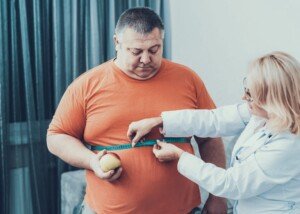The health dangers of obesity get much media coverage, but what of the mechanical difficulties that doctors have when performing exams hands-on in the office?
Physicians rely heavily on the ability of their fingers to feel for an abnormality.
They know exactly where to place their hands and fingers, how to palpate and when something doesn’t feel right.
They are so well-trained in this that they can even pick up an abnormality while palpating through clothes.
However, there is a limit to just how much thickness a doctor can feel through.
Obesity Creates an Obstruction to Palpation
Abdominal Examination

Shutterstock/Pormezz
“When feeling the abdomen, the doctor is checking for the size of the liver, spleen and kidneys,” says Dr. David Beatty, MD, a retired general practitioner with 30+ years of experience and an instructor of general medicine for 20+ years.
“The doctor is also feeling for swellings or growths that shouldn’t be there.
“A small tumor would be more difficult to feel through an obese abdomen.
“To give an analogy: take the case of a walnut sized tumor.
“If you lay a blanket over it you would feel the walnut. If you lay a duvet over it you might feel the walnut.
“If you lay a pillow over it you would be unlikely to notice it.”
And it isn’t just masses and size or organs that doctors feel through the skin for.
Their fingers can also pick up an abnormal pulse in the abdomen, which could suggest an abdominal aortic aneurysm.
Obesity would hamper the ability to detect this telltale pulse.
Internal Pelvic Examination
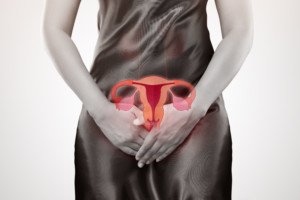
Shutterstock/Emily frost
“This is particularly difficult to assess through a larger abdomen,” says Dr. Beatty.
A pelvic exam involves the physician inserting fingers through a woman’s vaginal canal and checking various structures including the vulva, vagina, cervix, uterus and ovaries.
However, while one hand is performing this exam, the other hand is palpating the external pelvic and lower abdominal area.
Ovarian tumors have been detected this way.
Enough excess fat in the belly and surrounding areas will impede this entire process. This means that a malignant tumor can be missed.
Heart Examination

Freepik.com, peoplecreations
“When listening with a stethoscope it is technically harder to hear normal heart sounds and to pick up abnormal murmurs, if the chest wall is very thick due to obesity or heavy musculature,” says Dr. Beatty.
“The sounds have to travel further through the chest wall and are quieter to hear.”
You may have been surprised to read that heavy musculature can impede the physician’s ability to hear through a stethoscope.
But let’s look at that for a moment. Someone with heavy musculature but not excess fat – usually a football player or bodybuilder – is not nearly as likely to have heart problems when compared to the obese population.
After all, competitive athletes regularly exercise, usually don’t smoke, and are far more likely than the general population (thin, medium or fat) to have a heart healthy diet. Bodybuilders, in particular, tend towards a “clean” diet.
However, people with heavy musculature DO end up in cardiologists’ offices. And why is that?
Sometimes it’s just for a routine heart exam once they reach a certain age. Perhaps heart disease runs in their family.
They may also be having chest pains, in which case, they’ll often go to the emergency room.
In fact, chest pain is a very common reason for ER visits. Physicians see patients of all sizes and ages for this symptom.
However, most cases of chest pain in overall ER patients are not due to heart attack, as there are numerous benign causes of this unnerving symptom.
People with heavy musculature are not immune to non-cardiac chest pain, nor are they immune to cardiac chest pain or even heart attacks, for that matter.
But compared to the obese population, they are significantly less likely to experience cardiac chest pain.
In fact, it’s pretty well-known in the bodybuilding community that costochondritis – an inflammation of rib cartilage – can cause quite a bit of chest pain.
Another point worth noting is that in people with advanced musculature and low or normal body fat levels, this means that there’s no excess belly or pelvic area fat (they’re often quite lean in those locations) – making it easy for doctors to perform office exams in these areas.
Lung Examination
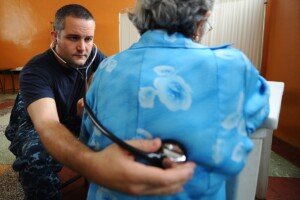
“The same is true when listening to lung sounds,” says Dr. Beatty. “It is harder to hear abnormalities in the lungs of a larger person.”
Obese, and especially morbidly obese, patients will have bulky layers of fat in their back, and the back is where a physician will place a stethoscope to listen to the lungs.
Clinical Breast Exam
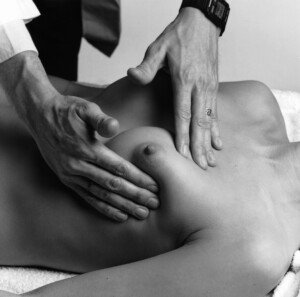
The more fat, from excess body weight, that’s in a breast, the less likely a doctor will be able to find a palpable lump.
Though thin women can have large breasts, we can’t ignore the fact that in an obese woman, there will be excess fat in the entire chest area that will reduce the efficacy of the clinical breast exam.
Getting Rid of Belly and Back Fat
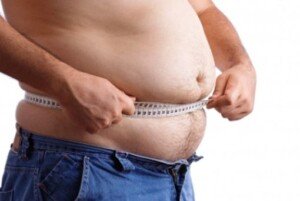
Fj.toloza992, CC BY-SA
Making it easier for doctors to perform office or ER exams is yet one more incentive to make continuous efforts to lose excess fat in the front of the body as well as the back – for both men and women.
Morbid obesity, especially, is very worrisome to physicians because this outright interferes with exams that can be revealing about current heart and lung health.
Finally, obesity makes it more difficult for nurses to “find a vein” from which to draw blood.
 Dr. Beatty has worked in primary medicine, surgery, accident and emergency, OBGYN, pediatrics and chronic disease management. He is the Doctor of Medicine for Strong Home Gym.
Dr. Beatty has worked in primary medicine, surgery, accident and emergency, OBGYN, pediatrics and chronic disease management. He is the Doctor of Medicine for Strong Home Gym.
 Lorra Garrick has been covering medical, fitness and cybersecurity topics for many years, having written thousands of articles for print magazines and websites, including as a ghostwriter. She’s also a former ACE-certified personal trainer.
Lorra Garrick has been covering medical, fitness and cybersecurity topics for many years, having written thousands of articles for print magazines and websites, including as a ghostwriter. She’s also a former ACE-certified personal trainer.
.


